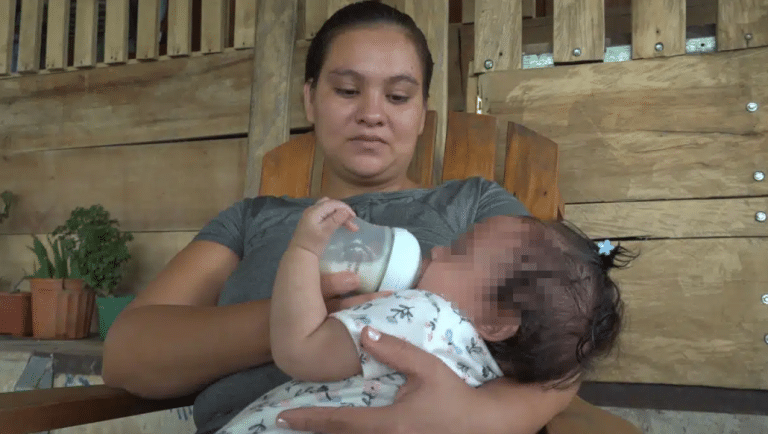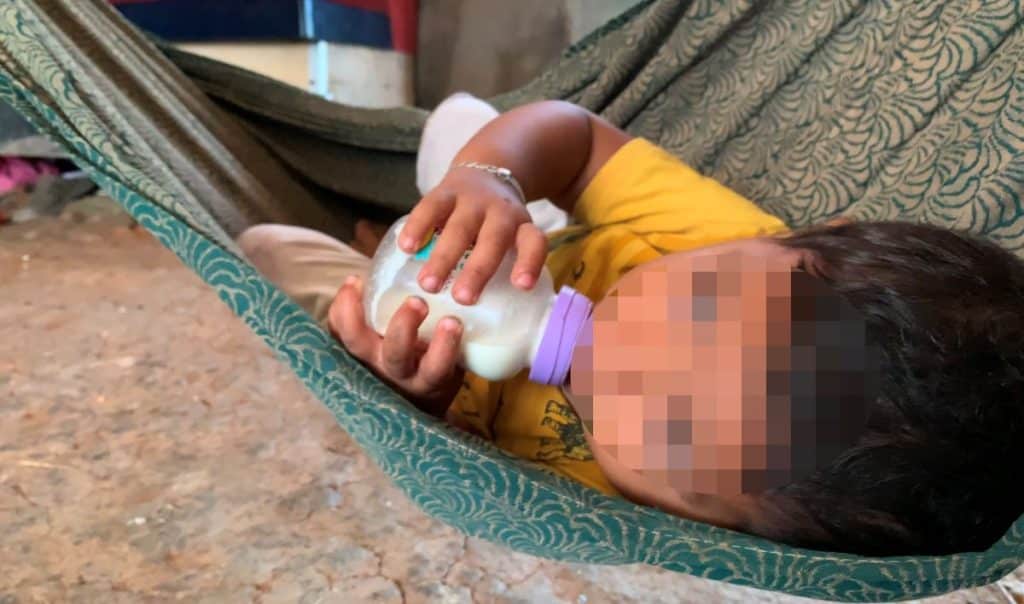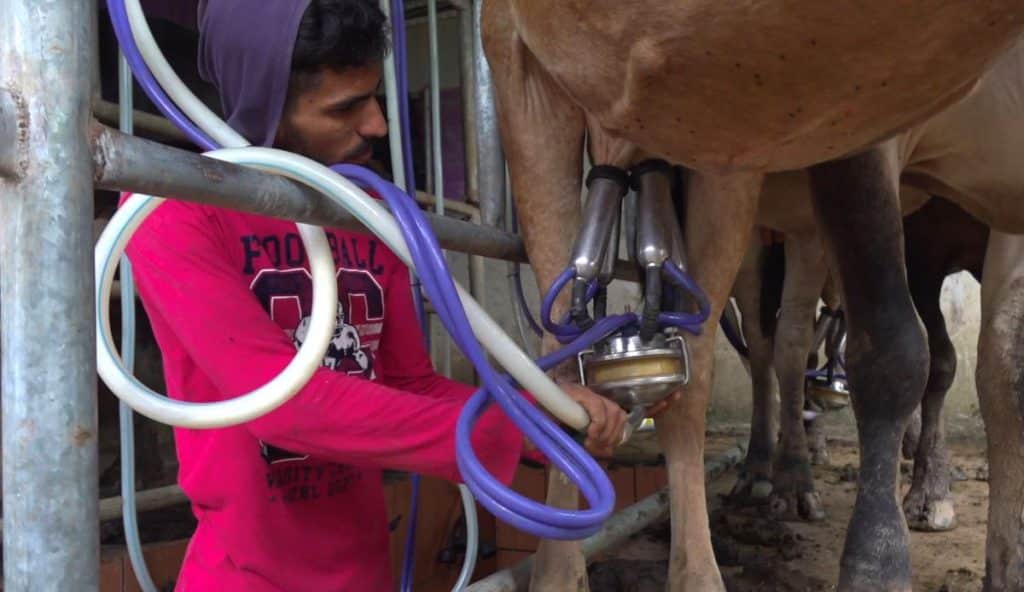13 de diciembre 2024

Twenty Human Rights Abuses Committed Against Nicaraguans by the Ortega-Murillo Regime

PUBLICIDAD 1M
PUBLICIDAD 4D
PUBLICIDAD 5D
Some twenty children have been born since 2018 in a camp for exiled Nicaraguan farmers in Upala, Costa Rica.“They give us hope,” those living there say

Tayling Orozco,24, fled to Costa Rica in October 2018, after Ortega-allied paramilitaries shot at her house on the island of Ometepe. Living in exile, she’s now the mother of two little girls. Photo: Confidencial
It’s 4:30 in the morning, and the sun is barely peeking through the distant hills that surround this lowland region of Upala, in northern Costa Rica. A woman arranges firewood in a fire pit built with stones and pieces of corroded iron, while her husband prepares his machete to go out to the field. A little girl finishes tucking her notebooks into a backpack. A baby lets out its first cry. Life in the rural camp for Nicaraguans has begun a new day.
There are no houses here, but there are homes. Some of the family dwellings still retain a shaky air of improvisation. The ground serves as their floor, and a few pieces of plastic form a roof. One or two families share the same space. But despite all that’s still lacking, there’s an atmosphere of solidarity and hope. “This space under construction has been one of peace, because being an exile isn’t easy, it’s difficult, extremely difficult,” says Tayling Orozco, 29, one of the residents.
Over 200,000 Nicaraguans have sought refuge in Costa Rica between 2018 and 2024, according to statistics from the head office of the Costa Rican Immigration Office.
Back in Nicaragua, Tayling’s mother was a government employee in 2013, when she chose to become involved in the protests against Ortega’s plan for an inter-oceanic canal, which involved expropriating the small farmers’ lands all along the proposed route. “I’ve always been a woman who has her own convictions and defends them, and that same quality was what led me later to participate in the 2018 protests for the freedom of Nicaragua,” she declares. Tayling’s level-headedness was exactly that which made her flee the regime of Daniel Ortega and Rosario Murillo at the highest point of the dictators’ so-called “Clean-up Operation,” aimed at violently squelching the citizen protests.
The refugee camp in Upala was founded in March 2019. From that time on, it’s been the first safe stopping place for Tayling. A group of exiled farmers, led by Francisca Ramirez – who’d been the most visible face of the rural Nicaraguans who demonstrated against Ortega and his canal project – rented these lands in order to begin again, and set to work doing what they’re masters of: tending the land and growing food. Since that time, 21 children have been born here, doubling the original population.

Among the new residents are two daughters born to Tayling and her partner Maynor: Sasha, 3, and Sahory, just a few months old. “When I was a teenager and went to school on Ometepe Island,, I was like a Cortes tree in bloom; full of life, colorful, strong, beautiful. However, exile and the regime’s violence dealt me deep wounds, and I feel I went from being that beautiful tree to one with dry branches and bark marked with machete blows, like a tree struck by lightning or attacked by a plague,” Tayling describes. “My daughters have been my salvation’ they’re my new roots, and they’ve made me feel reborn, sprouting new greenery, leaving behind those dry and damaged parts to bloom again,” she continues.
For the exiled families in this camp, the children are their main motivation. “Our children give us hope. They push us to fight to get ahead while we wait for the moment we long for, to return to Nicaragua,” states Maynor. This exiled father, like the rest in the camp, starts his days before dawn. His tasks include feeding the pigs, operating the tractor in the cornfield, and milking the cows.

The camp is a kind of island inhabited by Nicaraguans, but on Costa Rican soil. The farmers have rented these parcels of land in order to to produce, feed themselves and have an income. Corn, beans, yucca, and citrus are all fruits of their labor. They’ve also bought pigs and cows, whose numbers have tripled in just a few years. “We’ve received the support of some organizations, such as the UN High Commissioner for Refugees, but long ago we decided to be proactive, and to do what we already know how to do: produce,” says Francisca Ramirez.
Many of the children born in the camp have not reached school age, but those who are have integrated into local life. Their early years are unfolding between two cultures: their native Costa Rica and their parents' Nicaragua.
“We’re clear that [our children] are going to grow up with some closeness to the Costa Rican traditions, their friends, the words they use differently, for example; but as their fathers and mothers, we’re also instilling the love of Nicaragua, because we fled from there not because we planned to, but because we were forced out by the dictatorship. If things had been otherwise, they’d have been born in Nicaragua, and they’re also Nicaraguans,” affirms Tayling, a mother who still uses the Nicaraguan word lampazo for the mop that Costa Ricans call a palopiso.
Three-year-old Sasha sometimes says she’s a “Nitalaguan” – her way of saying Nicaraguan – but other times she defines herself as a “Tica,” (Costa Rican), her mother comments. “To us, it’s clear that they’ll grow up with love for both their countries, because although we’re Nicaraguans, they’ll be growing up in Costa Rica, learning in their schools, sharing with the Costa Ricans. Without a doubt, we’re going to teach them to love and respect Costa Rica, as the country they were born in and the place that sheltered us during the hardest times that we, their parents, faced. But they’re also going to love Nicaragua, where we came from,” she emphasizes. In the Nicaraguan exile camp, residents share similar stories of dispossession, resistance and hope. The arrival of these 21 babies has lit a spark of optimism among the community leaders.

While it’s true that things have improved, the fractures of exile continue just beneath the surface. The family separation for those like Tayling and Maynor, who had to flee the Ortega regime’s repression, is a pain that won’t disappear completely, and will be passed on in some ways to the new generations. “What they’re losing is having that connection with their larger family, because although I’m in exile, at least I feel supported by my family. Maybe not because my family sends me money, but I feel supported when my aunts or grandparents tell me: “Darling, I’m waiting for you. I love you, don’t worry, this will pass.” Or simply: “your home is here, and we’re waiting for you,” Tayling recounts, while her voice breaks and she can’t hold back the tears.
Amid the challenges, the community that has settled in this camp has begun to organize certain structures to guarantee that these children grow up surrounded by care and protection. The families have set up parcels of land for producing food, which are expanded over the years, and the community leaders are working with the Costa Rican NGOs and universities present in the zone to guarantee that the littlest ones will have access to a basic education.

Fathers and mothers like Tayling also seek to take advantage of every opportunity for their own growth. Tayling has resumed her undergraduate studies in the field of agriculture at the National Technical University. Other parents are receiving technical training in agribusiness. Little by little, familiarity with the Nicaraguan exile camp is overcoming the fear of “foreigners” that initially surrounded them in Upala, when the locals thought they were “squatters” or precaristas, as they say in Costa Rica. “We’ve drawn closer and closer to the general community. The people of Upala now see us as part of them, because the camp residents have never asked for a handout, but rather contributed to the community, for example by offering milk or cheese, grains and baked goods for school lunches,” Francisca, the community’s founder, states proudly.

The rural Nicaraguan exile camp was able to buy a tractor and a weeding machine to ease the workdays in the cornfield and increase production. They’ve received some training from the Costa Rican Universities to learn new phytosanitary techniques for dairy production, as they’re planning to soon begin commercializing their cheeses and other milk derivatives.
“Sahory has already been born into a less complicated situation. During my pregnancy with Sashita, there were some calves that were being bottle-fed. Now they’ve grown into dairy cows that have their own calves, so there’s milk, there’s cheese, and that gives us some income. There are some pigs that came to us with the support of an organization; the sows become pregnant, and then in about four months the piglets are born. We sell those piglets when they grow to weigh around 40 kilos,” Tayling explains.

Despite the distance that separates them from their homes in Nicaragua, Tayling and the other rural refugees hold tight to the hope of returning to Nicaragua someday. Meanwhile, each new birth is celebrated as one small victory amid the hardship.
To Tayling, the life of Sasha and Sahory and that of the other 21 children represents more than just a new stage of her personal story. It’s a reminder that even in the darkest hour, humanity can find ways to flourish. “They’re daughters of exile,” she declares firmly, “but they’re also seeds of hope.”
This article was published in Spanish in Confidencial and translated by Havana Times. To get the most relevant news from our English coverage delivered straight to your inbox, subscribe to The Dispatch.
PUBLICIDAD 3M
Confidencial es un diario digital nicaragüense, de formato multimedia, fundado por Carlos F. Chamorro en junio de 1996. Inició como un semanario impreso y hoy es un medio de referencia regional con información, análisis, entrevistas, perfiles, reportajes e investigaciones sobre Nicaragua, informando desde el exilio por la persecución política de la dictadura de Daniel Ortega y Rosario Murillo.
PUBLICIDAD 3D